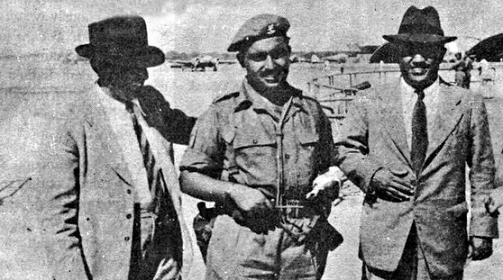Once Maharaja Hari Singh signed the Instrument of Accession with India on October 26, providing troops for the defence of Jammu and Kashmir became the responsibility of the Indian government. Shedding past lethargy and diffidence to help the state, some soldiers of 1 Sikh landed in Srinagar early on October 27, the very next day.
Once it became clear in Delhi that the tribal raiders were no pushovers, were well armed and organised, the Indian government doubled up its air efforts to induct more troops in the battles. It also decided to send in some forces by road via Pathankot-Jammu-Banihal road towards the Kashmir valley.
Men of 1 Kumaon (Paratroopers) were rushed in, and Tactical Headquarters of 161 Infantry Brigade were set up at the airport itself. Some soldiers of 3/15 Punjab and a composite company of 13 Battery Royal Indian Artillery were also on the front in initial days of the defensive build-up.
On October 31, D company of 4 Kumaon led by Major Somnath Sharma was also airlifted to Srinagar. During that day, 485 men and over 46,000 kg of supplies were carried by air to the Valley. It must be mentioned here that civilian air crew also joined these airlift operations, keeping pace with the Royal Indian Air Force.
By the first day of November, elements of 1 Sikh, 1 Kumaon, 1 Mahar and 4 Kumaon were available in Srinagar for digging in defences, and launching counter attacks. Colonel Harbaksh Singh reached Srinagar during the day and took charge of 161 Brigade. He played crucial roles in 1947-48 as also 1965 war with Pakistan. But more about him later, in another write-up.
On November 2, Brigadier L P Sen arrived in Srinagar and took over command from Col Singh. There was a lull in ground fighting and heavy air activity continued to bring in more troops, ammunition and other stuff into the Valley. It was on this day that around 140 men of 1 Patiala were also flown in and 34 sorties of Dakotas were flown.
On November 3, bitter fighting broke out between the raiders and the Indian forces. The tribals, by now, realised that they should capture the Srinagar airport as all the support of the Indian troops was being organised through the aerial route. Capturing the airport could have choked the build-up and cut off the Kashmir valley during winters altogether.
That morning, one company of 1 (Para) Kumaon and two companies of 4 Kumaon noved towards Budgam to find out more about enemy positions. While one company of 4 Kumaon returned to Srinagar a little after noon, the other company was attacked by 700 men at 2 pm just north of Budgam.
It now became clear that the objective of the raiders was to the capture of the airport. Greatly outnumbered, and surprised by the sudden attack, the men of 4 Kumaon dug in. More ammunition was rushed in to Kumaonis and seven air strikes were also launched on the raiders. Elements of 1 Kumaon who were rushed in to support 4 Kumaon could not break the attack of the determined raiders. The air attacks killed a large number of raiders but the Indian side also suffered heavy casualties.
At the end of the battle, 15 gallant Indian soldiers had died, and 26 men were wounded. Among those 15 was Major Somnath Sharma (image above) who had led these men and refused to withdraw an inch in the face of heavy enemy onslaught. He was awarded Param Vir Chakra (PVC) posthumously and became the first recipient of this highest battle honour.
The last message from Major Sharma, sent to his Brigade Headquarters, read: The enemy are only 50 yards from us. We are heavily outnumbered. We are under devastating fire. I shall not withdraw an inch but will fight to the last men and the last round.
On the same day, a message was received from the Pakistan Army that Gilgit had fallen into the hands of the Azad Kashmir government three days earlier. Brigadier Ghansar Singh, who was heading the Maharaja’s government at Gilgit, was taken captive. The story that had unfolded at Gilgit is a fascinating account of the gallantry of Dogra troops stationed there. In the coming days, we will discuss Gilgit-Baltistan and the latest developments there.
Sant Kumar Sharma, a seasoned journalist, is an authority on Jammu and Kashmir. Two of his books on Article 370 and Delimitation are already out. The third one on Indus Waters Treaty is now out and could be bought here.
Sant began as a teacher but after six years, joined the Indian Express, Chandigarh in 1990, the year when terrorism was taking its first step in J & K and soon there would be exodus of lakhs of Kashmiri Pandits from the Valley. He subsequently worked for The Statesman, The Times of India and Star News among others. He is based in Jammu since May 2000.


